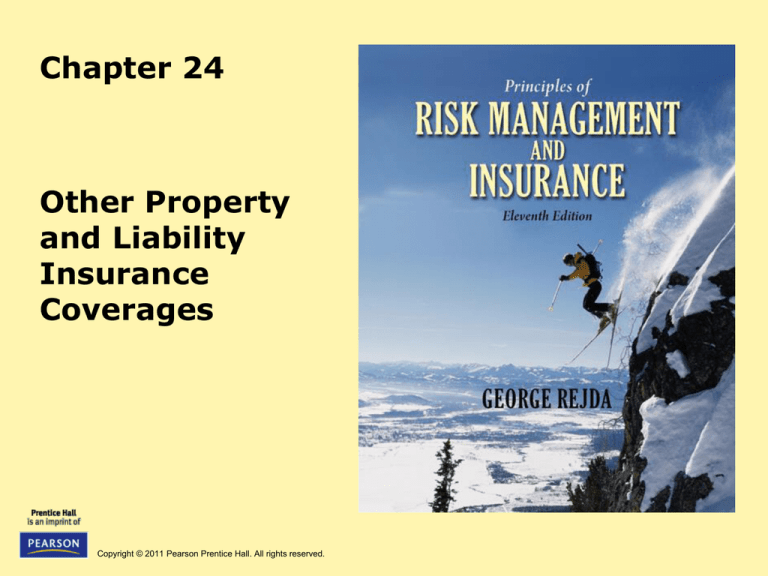
Chapter 24
Other Property
and Liability
Insurance
Coverages
Copyright © 2011 Pearson Prentice Hall. All rights reserved.
Agenda
•
•
•
•
•
•
•
ISO Dwelling Program
Mobilehome Insurance
Inland Marine Floaters
Watercraft Insurance
Government Property Insurance Programs
Title Insurance
Personal Umbrella Policy
Copyright © 2011 Pearson Prentice Hall. All rights reserved.
24-2
ISO Dwelling Program
• Some dwellings that are ineligible for coverage under the HO
policy can be insured under an ISO dwelling policy
– The forms are narrower in coverage and there is no coverage for
theft or personal liability, unless the policy is endorsed
– Dwelling Property 1 (basic form) provides coverage similar to
Coverages A-D of the Homeowners Policy
• Only a limited number of named perils apply to both the dwelling and
the personal property
– Additional perils can be added for an additional premium
• Coverage D covers the fair rental value if part of the dwelling is rented
Coverage E can be added to provide coverage for additional living
expenses
• All covered property losses are paid on an actual cash value basis,
with some exceptions
Copyright © 2011 Pearson Prentice Hall. All rights reserved.
24-3
ISO Dwelling Program
– Dwelling Property 2 (broad form) covers losses to the dwelling
and other structures on a replacement cost basis
• The form also includes a benefit for additional living expense
(Coverage E)
• The list of named perils is expanded
– Dwelling Property 3 (special form) covers the dwelling and
other structures on an “all-risks” basis
• All direct physical losses to the dwelling and other structures are
covered except those losses specifically excluded
• Personal property is covered for the same named perils found in
the broad form
– Endorsements to the dwelling form include:
• Theft coverage
• Personal liability supplement
Copyright © 2011 Pearson Prentice Hall. All rights reserved.
24-4
Mobilehome Insurance
• Under the ISO program, mobilehome insurance is
written by adding an endorsement to an HO-2 or
HO-3 policy
– The mobilehome must be at least 10 feet wide and 40
feet long, and capable of being towed on its own chassis
– The coverage is similar to the HO policy
• Coverage A covers the mobilehome on a replacement cost
basis
– An optional actual cash value endorsement can be added to
reduce the cost
• An additional coverage pays up to $500 for the cost
incurred in transporting the mobilehome to a safe place to
avoid damage when it is endangered by a covered peril,
such as a fire
Copyright © 2011 Pearson Prentice Hall. All rights reserved.
24-5
Inland Marine Floaters
• An inland marine floater is a policy that provides broad and
comprehensive protection on property frequently moved
from one location to another
– Coverage can be tailored to the specific type of personal
property to be insured, e.g., jewelry, coins, or stamps
– Desired amounts of insurance can be selected
– Broader and more comprehensive coverage can be obtained
• All direct physical losses are covered unless excluded
– Most floaters cover insured property anywhere in the world
– Inland marine floaters typically do not impose a deductible
Copyright © 2011 Pearson Prentice Hall. All rights reserved.
24-6
Inland Marine Floaters
• The personal articles floater (PAF) is an inland marine
floater that provides comprehensive protection on valuable
personal property
– This coverage can be written as a stand-alone contract
• Insures certain classes of property on an “all-risks” basis
• Classes of property that can be covered include jewelry, furs,
cameras, fine arts, etc.
– The coverage can also be added as a scheduled personal
property endorsement to an HO policy
• Coverage is essentially the same as provided by the freestanding
PAF
Copyright © 2011 Pearson Prentice Hall. All rights reserved.
24-7
Watercraft Insurance
• The homeowners policy provides limited coverage for boats
• A boatowners package policy combines physical damage
insurance on the boat, medical expense insurance, liability
insurance, and other coverages into one policy
– Physical damage is covered on an “all-risks” basis
– The insured is covered for property damage and bodily injury
liability arising out of negligent use of the boat
– The policy also includes medical expense coverage and an
uninsured boaters coverage (may be optional)
Copyright © 2011 Pearson Prentice Hall. All rights reserved.
24-8
Watercraft Insurance
• Yacht insurance is designed for larger boats
– Policies are not standard, but have many common
features
– Physical damage to the yacht and its equipment is
covered on an “all-risks” basis
– The policy includes liability coverage, medical
expense coverage, and uninsured boaters coverage
Copyright © 2011 Pearson Prentice Hall. All rights reserved.
24-9
Government Property Insurance
Programs
• Some government insurance programs are necessary because
certain perils are difficult to insure privately
– Coverage may not be available or may not be affordable
• The National Flood Insurance Program provides insurance
coverage to property owners in flood-prone areas
– Flood insurance is purchased from agents or brokers who
represent private insurers
• The private insurers sell federal flood insurance under their own
names, collect the premiums, and receive an expense allowance
• The federal government is responsible for all underwriting losses
• The program is not currently self-supporting, due to losses from
Hurricane Katrina and other hurricanes in 2005
Copyright © 2011 Pearson Prentice Hall. All rights reserved.
24-10
Government Property Insurance
Programs
– Buildings and their contents can be covered by flood
insurance if the community agrees to adopt and enforce
sound flood control and land use measures
• A flood hazard boundary map shows the general areas of
flood losses
• Residents can purchase limited amounts of insurance at
subsidized rates under the emergency portion of the
program
– A flood is defined in the Standard Flood Insurance Policy
as:
• A general and temporary condition of partial or complete
inundation of two or more acres of normally dry land area
or of two or more properties (at least one of which is your
property) from overflow of inland or tidal waters, from
unusual and rapid accumulation or runoff of surface waters
from any source, or from mudflow
Copyright © 2011 Pearson Prentice Hall. All rights reserved.
24-11
Exhibit 24.1 Amount of Federal Flood
Insurance under the Emergency and Regular
Programs
Copyright © 2011 Pearson Prentice Hall. All rights reserved.
24-12
Government Property Insurance
Programs
• Flood insurance coverage is available in three Standard Policy
Forms:
– The Dwelling Form is used to insure one- to four-family
residential buildings and single family dwelling units in a
condominium building
– The General Property Policy Form is used to insure five or more
family residential buildings and non-residential buildings
– The Residential Condominium Building Association Policy Form is
issued to residential condominium associations on behalf of
association and unit owners
Copyright © 2011 Pearson Prentice Hall. All rights reserved.
24-13
Government Property Insurance
Programs
– There is a 30-day waiting period for new applications and
endorsements for flood coverage
• This prevents property owners from waiting to purchase
coverage until an imminent flood threatens their property
– The cost of protection is relatively low
• The average flood insurance policy costs about $400 annually,
and is less expensive than interest on federal disaster loans
– The federal flood insurance program faces several critical
problems, for example:
• The NFIP has a substantial deficit, largely due to Hurricane
Katrina
• Some have proposed adding windstorm coverage to the
program
• There is a low level of participation by property owners who
reside in flood zones
Copyright © 2011 Pearson Prentice Hall. All rights reserved.
24-14
Exhibit 24.2 Summary of Property Covered
under National Flood Insurance Program
(NFIP)
Copyright © 2011 Pearson Prentice Hall. All rights reserved.
24-15
Government Property Insurance
Programs
• The Urban Property and Reinsurance Act of 1968 created
FAIR plans (Fair Access to Insurance Requirements)
– Plans provide coverage to urban property owners who are
unable to obtain coverage in the standard market
• Covers property for fire and extended-coverage perils, vandalism,
and malicious mischief
• Seven states have beach and windstorm plans, where property is
vulnerable to damage from severe windstorms and hurricanes
– A state with a FAIR plan creates a pool or syndicate of private
insurers to provide basic property insurance
• Each insurer in the pool is assessed its proportionate share of
losses and expenses based on the proportion of property insurance
premiums written in the state
Copyright © 2011 Pearson Prentice Hall. All rights reserved.
24-16
Title Insurance
• Title insurance protects the owner of property or the lender of
money for the purchase of property against any unknown
defects in the title to the property under consideration
– If there is a defect in a title, the owner could lose the property to
someone with a superior claim
– Examples of defects to the title include an invalid will, incorrect
description of the property, and undisclosed liens
– The policy provides protection against title defects that have
occurred in the past, prior to the effective date of the policy
– The insurer assumes no losses will occur
– The premium is paid only once when the policy is issued
– The policy term runs indefinitely into the future
– If a loss occurs, the insured is indemnified in dollar amounts up to
the policy limits (usually the purchase price of the property)
Copyright © 2011 Pearson Prentice Hall. All rights reserved.
24-17
Personal Umbrella Policy
• The personal umbrella policy provides protection against a
catastrophic lawsuit or judgment
– Excess liability insurance is provided in amounts from
$1–$10 million
– Certain minimum amounts of liability insurance must be carried
on the underlying contracts
– Coverage is broad and includes protection against certain losses
not covered by the underlying contracts
• For example, the policy covers liability for personal injury (e.g., false
arrest, slander)
– A self-insured retention must be satisfied for losses covered by
the umbrella policy but not by any underlying contract
– The umbrella policy is reasonable in cost
Copyright © 2011 Pearson Prentice Hall. All rights reserved.
24-18
Exhibit 24.3 Typical Underlying Coverage
Amounts Required to Qualify for a Personal
Umbrella Policy
Copyright © 2011 Pearson Prentice Hall. All rights reserved.
24-19
Personal Umbrella Policy
– Insurers can use a standard Personal Umbrella Policy developed by
the ISO
– The policy pays for damages in excess of the retained limit for
bodily injury, property damage, or personal injury for which the
insured is legally liable
• The retained limit is either:
– The total limits of the underlying insurance or any other insurance available
to an insured, or
– The deductible stated in the declarations if the loss is covered by the
umbrella policy but not by any underlying insurance or other insurance
– Exclusions include liability for expected or intentional injury,
certain personal injury losses, business liability, and professional
services
Copyright © 2011 Pearson Prentice Hall. All rights reserved.
24-20







